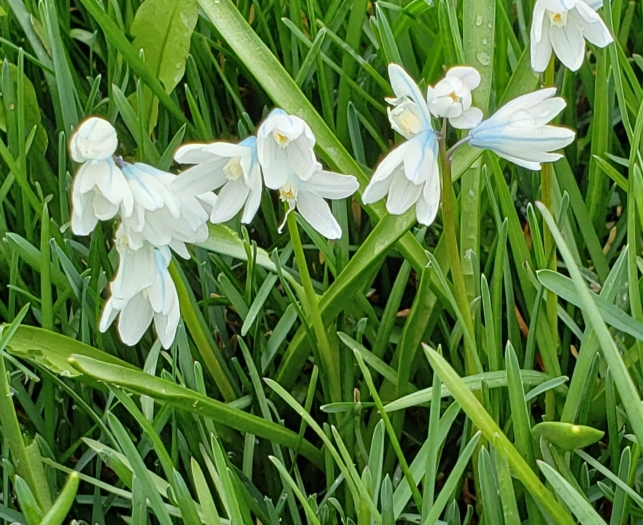Striped Squill
(Puschkinia scilloides)
Striped Squill (Puschkinia scilloides)
/
/

Rita Shaw
Public Domain
Image By:
Rita Shaw
Recorded By:
Copyright:
Public Domain
Copyright Notice:
Photo by: Rita Shaw | License Type: Public Domain | License URL: http://creativecommons.org/publicdomain/zero/1.0/ | Rights Holder: Rita Shaw | Publisher: iNaturalist | Date Created: 2021-04-15T13:49:07-07:00 |















































Estimated Native Range
Summary
Puschkinia scilloides, commonly known as striped squill or Lebanon squill, is a bulbous perennial herb native to alpine meadows and rocky slopes in the Caucasus and the Middle East. It typically grows to about 10–15 cm (4–6 in) tall and is characterized by two narrow basal leaves that are oblanceolate, widening towards the tips. The inflorescence, a dense raceme with up to 20 flowers, emerges in early spring. Each flower is pale blue with a darker blue central stripe on each tepal and features a distinctive small cup surrounding the stamens and style. Striped squill is noted for its early bloom time, often being one of the first flowers to emerge in spring, signaling the end of winter.
Striped squill is valued for its ability to naturalize and provide early spring color in gardens. It is often used in rock gardens, woodland plantings, and as a ground cover under deciduous trees. It thrives in cool positions with well-drained soil and can tolerate full sun to part shade. While it requires medium amounts of water, it is important to avoid waterlogged conditions, especially during dormancy in the summer. Striped squill is relatively low maintenance and can be left undisturbed for several years to form attractive colonies. It is rarely affected by pests or diseases, making it a trouble-free addition to the garden.CC BY-SA 4.0
Striped squill is valued for its ability to naturalize and provide early spring color in gardens. It is often used in rock gardens, woodland plantings, and as a ground cover under deciduous trees. It thrives in cool positions with well-drained soil and can tolerate full sun to part shade. While it requires medium amounts of water, it is important to avoid waterlogged conditions, especially during dormancy in the summer. Striped squill is relatively low maintenance and can be left undisturbed for several years to form attractive colonies. It is rarely affected by pests or diseases, making it a trouble-free addition to the garden.CC BY-SA 4.0
Plant Description
- Plant Type: Bulb
- Height: 0.3-0.5 feet
- Width: 0.3-0.5 feet
- Growth Rate: Moderate
- Flower Color: Blue, White
- Flowering Season: Spring
- Leaf Retention: Deciduous
Growth Requirements
- Sun: Full Sun, Part Shade
- Water: Medium
- Drainage: Fast
Common Uses
Bee Garden, Border Plant, Deer Resistant, Drought Tolerant, Fragrant, Groundcover, Low Maintenance, Potted Plant, Rock Garden, Showy Flowers
Natural Habitat
Alpine meadows and rocky slopes in the Caucasus and the Middle East
Other Names
Common Names: Striped-Squill, Lebanon Squill, Puschkinie Faux-Scille, Buishyacint, Porslinshyacint
Scientific Names: , Puschkinia libanotica, Puschkinia scilloides, Puschkinia scilloides var. libanotica, Adamsia scilloides, Puschkinia hyacinthoides, Puschkinia sicula,
GBIF Accepted Name: Puschkinia scilloides Adams